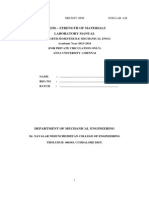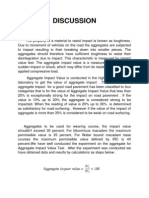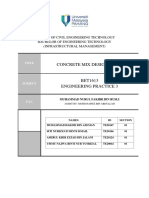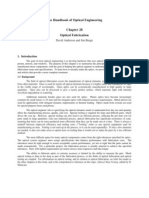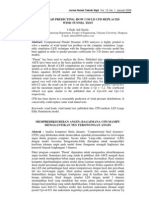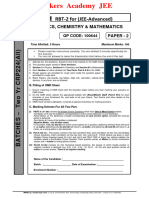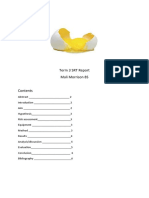Material Property Report
Uploaded by
a4idMaterial Property Report
Uploaded by
a4idIntroduction
There are three types of properties involved when selecting a material; which are chemical
property, physical property, and mechanical property. Here, we will be focussing on mechanical
property which deals with the force applied to the material. Property of material is very important
when selecting a material for any applications. Because it is crucial to select the safest and most
effective material for the application. We will be testing sample materials for its property through
tensile testing, hardness testing, and impact testing.
Objectives.
1. Relate properties and applications
2. Effect of % Carbon on properties of steel
3. Study about the fracture mechanism of each materials
4. Relation between HR and TS of steel and their use
5. Application about tensile and impact result
6. Effect of strain rate on material
Pitichai Rajatawipat • ADME Section 6 • Chulalongkorn University
Theory
1. Strength
The strength of a metal is the ability to withstand the action of external forces without
breaking. This property is inherent in the material itself and must be determined by experiment.
Tensile strength, also called ultimate strength, is the maximum strength developed in a metal in a
tension test. The tension test is a method for determining the behavior of a material under an actual
stretch loading. This test provides the elastic limit, elongation, yield point, yield strength, tensile
strength, and the reduction in area.
1.1 Tension test
To perform the tension test a specimen of the material is made into a standard shape and size.
Before testing, two small punch marks are identified along the specimen’s length. These marks are
located away from both ends of the specimen because the stress distribution at the ends is somewhat
complex due to gripping at the connections. Example is shown in Fig. 1(a).In order to apply an
axial load with no bending of the specimen. A testing machine like the one shown in Fig. 2 is then
used to stretch the specimen at a very slow, constant rate until it reaches the breaking point. The
Result is load required to maintain this uniform stretching.
Fig. 1 Typical steel specimen
A frequency interval during the test, data is recorded of the applied load P, as read on the dial
of the machine or taken from a digital readout. Also, the elongation δ = L − L0 between the punch
marks on the specimen may be measured using an extensometer. This value of δ(delta) is then used
to calculate the average normal strain in the specimen. It is also possible to read the strain directly
by using an electrical-resistance strain gauge, which looks like the one shown in Fig. 3. The
operation of this gauge is based on the change in electrical resistance of a very thin wire or piece of
metal foil under strain.
Fig. 2 Tensile testing machine
Pitichai Rajatawipat • ADME Section 6 • Chulalongkorn University
Fig. 3 Strain gauge
1.2 The stress-strain diagram
There are two ways in which it is normally described.
1.2.1 Conventional stress-strain diagram
The nominal or engineering stress is determined by dividing the applied load P by the
specimen’s original cross-sectional area A0. This calculation assumes that the stress is constant over
the cross section and throughout the region between the gauge points.
Nominal or engineering strain is found directly from the strain gauge reading, or by dividing the
change in the specimen’s gauge length, δ, by the specimen’s original gauge length L0. Here the
strain is assumed to be constant throughout the region between the gauge points. Thus,
1.2.2 True stress-strain diagram
The stress and strain computed by using actual cross-sectional area and specimen length at the
instant the load is measured are called true stress and true strain, and a plot of true stress and true
strain is called the true stress-strain diagram. The plot is shown by the light line in Fig. 4. Both the
conventional and true stress-strain diagram are practically coincident when the strain is small. The
differences between the diagrams begin to appear in the strain-hardening range, where the
magnitude of strain becomes more significant. In particular, there is a large divergence within the
necking region. Here it can be seen that the specimen actually supports a decreasing load, since A0
is constant when calculating engineering stress, σ=P/A0. However, from the true stress-strain
diagram, the actual area A within the necking region is always decreasing until fracture, σf’.
Therefore, the material actually sustains increasing stress, since σ=P/A.
The tensile test specimen also provides another property of metal known as its modulus of
elasticity, also called Young`s modulus, E. This is the ratio of the stress to the elastic strain. It
relates to the slope of the curve to the yield point. The modulus of elasticity is important to the
designers and is incorporated in many design formulas.
Pitichai Rajatawipat • ADME Section 6 • Chulalongkorn University
1.2.3 Ductility (Ductile materials)
The ductility of a metal is the property that allows it to be stretched or otherwise changed in
shape without breaking and to retain the changed shape after the load has been removed. The
ductility of a metal can be determined from the tensile test. This is done by determining the percent
of elongation and percent reduction in area.
Percent elongation
Gauge marks are made across the point where fracture will occur. The increase in gauge
length related to the original length times 100 is the percentage of elongation.
Percent reduction in area
Reduction of area is another measure of ductility and is obtained from the tensile test by
measuring the original cross-sectional area of the specimen and relating it to the cross-sectional area
after failure.
1.2.4 Brittle materials
Materials that exhibit little or no yielding before failure are referred to as brittle materials.
Gray cast iron is an example, having a stress-strain diagram in tension as shown in portion AB of
the curve in Fig. 4.
Fig.4 Stress‐Stain diagram for gray cast iron
Pitichai Rajatawipat • ADME Section 6 • Chulalongkorn University
1.2.5 Strain energy
The energy related to the strains in the material is called strain energy. It is convenient to
formulate the strain energy per unit volume of material. This is called the strain energy density.
Modulus of resilience
When the stress reaches the proportional limit, the strain energy density is referred to as the
Modulus of resilience (Fig. 8(a)). Physically a material’s resilience represents the ability of the
material to absorb energy without any permanent damage to the material.
2. Hardness
The hardness of a metal is defined as the resistance of a metal to local penetration by harder
substance. The hardness of metals is measured by forcing a hardened steel ball or diamond into the
surface of the specimen, under a definite weight, in a hardness testing machine.
The popular machine is the Rockwell hardness tester, which utilizes a diamond that is forced
into the surface of the specimen. Different loads are used to provide different scaled. Smaller loads
are used for softer materials
Basics of Rockwell Hardness Testing
Fig. 5
Pitichai Rajatawipat • ADME Section 6 • Chulalongkorn University
Basics of Brinell Hardness Testing
Fig.6
Relation of hardness to other material properties
3. Impact Resistance
Resistance of a metal to impacts is evaluated in terms of impact strength. A metal may possess
satisfactory ductility under static loads but may fail under dynamic loads or impact.Impact strength
is most often determined by the Charpy test. It is sometimes measured by the Izod test. Both types
of tests use the same type of pendulum-testing machine. The Charpy test specimen is a beam
supported at both ends and contains a notch in the center. The specimen is placed on supports and
struck with a pendulum on the side opposite the notch. The accuracy and location of the notch is of
extreme importance.
Impact Test
The impact test is a standardized high strain-rate test which determines the amount of energy
absorbed by a material during fracture. This absorbed energy is a measure of a given material's
toughness and acts as a tool to study brittle-ductile transition.
Pitichai Rajatawipat • ADME Section 6 • Chulalongkorn University
Fig. 7 Impact test
Charpy Impact Test
The test specimen is machined to a 10mm x 10mm (full size) cross-section, with either a "V"
or "U" notch. Sub-size specimens are used where the material thickness is restricted. Specimens can
be tested down to cryogenic temperatures.
Pitichai Rajatawipat • ADME Section 6 • Chulalongkorn University
Experiment
Apparatus
Tensile test
The universal testing machine, Shimadzu Autograph AG-IS—100 kN, is
used to perform the tensile test. The forces are obtained directly from load cell of the
testing machine. An extensometer with gauge length 50 mm is used to detect the
displacement during the tests. The tests are controlled and the raw data of load and
displacement are collected by using the computer programming.
Fig. 8 The universal testing machine
Fig. 9 specimen
Pitichai Rajatawipat • ADME Section 6 • Chulalongkorn University
Hardness test
The Avery Type 6402, Hardness Tester are used. The tests are
performed following the standard and the results are directly read from the machine.
Check the calibration of the Rockwell Machines with Standard Calibration Test Blocks
for the scale selected.
Fig.
10
Avery
6402
Impact test
The AVERY type 6703 impact tester are used to determine the impact
toughness of steel and aluminum. The pendulum is used to strike the standard specimen. The impact
toughness is directly read from the machine.
Fig. 11 Avery 6703
Pitichai Rajatawipat • ADME Section 6 • Chulalongkorn University
Description of Measurands and Measurement Instruments
Micrometer used to measure the sizes of specimens
Extensometer for measuring displacement for tensile test
Notch checked equipment and specimen setting equipment for impact test
Procedure
Tensile test
This experiment we used the computer to correct the data. The extensometer will measure
the elongation data of material and the computer program will use this data to plot the graph. This
lab we should be careful about the grip because this equipment is expensive and easily to broken.
1. Preparation of the test machine.
2. Measure the dimension and find the average dimension of each specimens.
3. Mark 8 points of 70 mm gauge lengths on the specimen (The failure should occur sway to the
smaller diameter side.)
4. Set the computer by chose the information that wanted from the graph; example, Break force,
stoke, yield point, and etc.
5. The capacity set to 100 kN, install data collected from each specimens.
6. Set the system to focus on the position of gauge marks to protect the damage happen to the
extensometer.
7. Insert the specimen into the tensile testing machine by tight the top end to the load cell.
8. Connect an extensometer at the 70 mm marks of the specimen. (For the first use of the opening
machine, the tensile testing machine must be calibrated.
9. Computer could set up the system.
10. Set the stoke value to be zero, the elongate value could be found correctly
Pitichai Rajatawipat • ADME Section 6 • Chulalongkorn University
11. Extension value also set to be zero, because the initial length is not extended.
12. Tight the other end of the specimen to the load cell.
13. Collect the value of the initial force.
14. Set the removal extensometer warning that suit to the material.
15. Start the test.
16. Immediately remove the extensometer after warning showed at the desktop of computers. This
process you should be carefully because this equipment is very expensive.
17. The specimen fail then removed from the extensometer. This process will occur the noise sound
when material.
18. Measure the final length of the marked points and measure the necking point.
19. Replacement of specimen.
*Note that only brass that necking will occur at the center of work pieces so you should connect the
extensometer at center of work piece. Other work piece we connect extensometer at lower the center.
Hardness test
The hardness testing can be done by many methods for example Rockwell, Brinell,
Vickor which will give the different result. All of the results need to be comparing to the table of
each test to see the result. Our tests use the Rockwell to do the tests which have the different scale
due to the material that we use.
1.Clean the surface of the testing material by grinding
2.Use the sand paper to clean up the surface.
3.Calibrate the testing machine before the testing.
4.Measure the thickness of the testing piece.
5.Find the spot that want to press it.
6.Press the testing piece by applies the minor load which is 10kgf.
7.Apply the major load to the work piece and hold about 10-15 second due to the material and
release the major load and read the value.
Pitichai Rajatawipat • ADME Section 6 • Chulalongkorn University
8. The pressing use the cell load to press, in each scale use different weight of cell load. The scale
C is press by the total weight of 150kgf and scale B is use the total weight of 100kgf. We
should use the suitable scale for each material. Check the scale should we used by the value
of the hardness if it not in range 20-70 we change the scale.
9.We check 2 times for sure that the material in the suitable scale.
10.If the hardness over the range we change the scale but if it in range we continue the test.
11.The scale that we use is control by the indenter and the material properties and the specimen of
the testing piece.
12. Replacement of specimen.
Impact test
The impact testing can be done by using the work piece which have the specimen that
require from the testing machine.
1. Check the specimen of the work piece.
2. Calibrate the machine.
3. Swing the hammer without any work piece then read the error of the machine and mark out so
we can adjust with the result.
4. Put the hammer and the specimen into position.
5. Release the hammer to the strike specimen and reading the result and done forget to adjust it
with the error of the machine.
6. Replacement of specimen.
Pitichai Rajatawipat • ADME Section 6 • Chulalongkorn University
Results
Tensile test
From the data acquired from the experiment, we can draw a stress-strain curve like the one
shown in Figure 12. From the graph we can see that shaft steel has the highest yield strength. The
material with the highest toughness is stainless steel. We can see the behavior of each material
before it breaks too, the most exciting one is Brass which necking does not occur. The construction
steel has the highest difference between yield and tensile strength and has the longest yield.
The Modulus of Elasticity can be computed by the slope of the elastic period. The yield
point can be defined with the 0.2% offset. Calculations are available in Appendix E, values are
shown in Table 1.
Table 1
Modulus of
Material Yield Strength (MPa) Tensile Strength (MPa)
Elasticity (MPa)
Aluminum 66.35 219.53 243.73
Brass 97.29 318.77 424.39
Construction Steel 210.01 486.04 678.22
Shaft Steel 172.29 669.93 858.55
Stainless Steel 178.78 617.12 722.63
Pitichai Rajatawipat • ADME Section 6 • Chulalongkorn University
X
X
X
Fig. 12 Stress-Strain Curve
Fig. 13 Stress-Strain Curve of Steel
*Note: Discussion of this graph is available in the discussion part
Pitichai Rajatawipat • ADME Section 6 • Chulalongkorn University
Hardness test
The result of hardness test can be viewed in Table 2 below. For this experiment, we will be
using two main scales; HRB and HRC for determining the hardness. We used scale HRH for
Aluminum. We need to test first if the material exceed 20 on the scale, if yes you must use scale
HRC if not we can use HRB.
And from the Appendix C we can convert HRB to HRC and even to HRN. The hardness of
material can be used to convert to tensile strength from this table. We can compare the converted
tensile strength to the ones tested by tensile testing in Figure 12. The % error of tensile strength is
also calculated and shown in Table 2.
Table 2
Converted
Material HRC HRB HRH tensile strength %error
(MPa)
Aluminum 99.50
Brass 68.00
676
Construction Steel 13.00 94.00 **tensile test 0.30%
678.22
814
Shaft Steel 23.00 100.00 **tensile test 5.20%
858.88
Impact test
The result of Charpy impact testing is shown in Table 3. We have already minus 2 for
Average Energy
Material Trial 1 Trail 2 Trail 3
Lost (ft.lb)
Aluminum 18 22 19 21
Brass 12 13 14 13
Shaft Steel 26 24 28 26
friction of the hammer. Temperature while testing is 29 degree Celsius.
Table 3
Pitichai Rajatawipat • ADME Section 6 • Chulalongkorn University
Discussion
1. Materials properties and application
Aluminum: Aluminum is the most abundant metal in the Earth’s crust. It has high strength-
per-weight ratio. Thus it is extensively used in application that requires low weight and good
strength. Applications such as automobile parts, packaging (cans, foils, etc.), constructions
(windows, doors, etc.), and CPU heat sinks are composed of aluminum.
Brass: Brass is an alloy of copper and zinc. It has high hardness and is water resistance.
Applications using brass are water pipes, and musical instrument. The on the downside, brass is
quiet expensive and allows less elastic movement.
Stainless Steel: Stainless steel has high oxidation-resistance in air at ambient temperature.
It can be used in constructing structure but is not extensively used due to its high price. Applications
where stainless steel excel are cookware, cutlery, surgical instrument.
Shaft Steel: As the name says, it is often used in producing shaft for high load power
transmitting. Due to its hardness, it can operate under high load before plastic deformation begins.
Construction Steel: The construction steel has the greatest ability to absorb energy.
Because in construction for safety, we can’t allow the concrete to crack. The steel also has high
ductility for absorption.
2. Effect of % Carbon on properties of steel
The % carbon in steel has the ability to alter the steel’s properties. As we can see from the
graph for instance, construction steel has lower carbon than shaft steel. As a result, the construction
steel is more ductile than that of shaft steel. Also it is more harder than shaft steel. Thus, the more
carbon presented in the steel, the steel becomes more brittle and more harder.
3. Study about the fracture mechanism of each materials
The study of fracture mechanism would allow us to determine the difference in fracture
surface between brittle and ductile materials. By doing the tensile test, we saw that ductile material
induces the “cup and cone” behavior. The ductile material failed by maximum shear direction of 45
degree. On the other hand, brittle material have a flat surface is seen in impact testing of brass.
Brass, as a brittle material does not have necking while fracture, it breaks instantly. While ductile
materials have necking and air gaps.
Pitichai Rajatawipat • ADME Section 6 • Chulalongkorn University
4. Relation between hardness value and tensile strength
The tensile strength of steel can be achieved by testing the hardness first to obtain the value
of hardness then convert it to tensile strength through the conversion table. But for some material,
there are no hardness value in the table, so we can not determine the tensile strength of it. The
tensile strength obtained from the table if compared to the tested tensile strength achieved by tensile
testing is appropriate and safe. Although there are some minor errors but the wide range of the
curves are acceptable.
5. Application about tensile and impact result
From tensile test we can achieve the toughness of each material by determining the area
under each curve. For example, the area of Brass is three times more than that of Aluminum. But in
impact test, we achieve the toughness directly from the data. In impact testing Aluminum is two
times more than that of Brass. The ratio change is caused by strain rate. Tensile test have low strain
rate, on the other hand impact test has very high strain rate.
6. Effect of strain rate on material
Strain rate is the rate at which the material deforms. Material having high strain rate tends to
be more brittle than those having lesser strain rate. Thus, brittle material have less toughness than
ductile material. Each types of tests also induce the strain rate of material. Impact test causes the
high strain rate of the material while tensile test causes low strain rate on the material. Although the
decreasing in toughness caused by the strain rate is not the same in each material.
Pitichai Rajatawipat • ADME Section 6 • Chulalongkorn University
Conclusion
From the experiment, we are able to select the most appropriate material for a specified
application upon knowing the material’s properties. We also know that the carbon content presented
in the steel affects its ductility, the lower the carbon the higher the ductile. More over, we learned
about the fracture of each type of material; ductile material tends to break in cup&cone shape while
brittle material tends to break flat. We can also predict the tensile strength of a material from
hardness test and the value is more safe than the ones gathered from the stress-strain curve. We can
find the material’s toughness by using area under curve for tensile test and compare directly for
impact test, strain rate is what determine the change in strain rate. And last, we learned that the
strain rate are different in each type of tests; tensile test will induce low strain rate to the material
while impact test will induce very high strain rate.
Pitichai Rajatawipat • ADME Section 6 • Chulalongkorn University
Appendix
Appendix A
Typical Application of Rockwell Hardness Scales
HRA
.
.
.
.
Cemented
carbides,
thin
steel
and
shallow
case
hardened
steel
HRB
.
.
.
.
Copper
alloys,
soft
steels,
aluminium
alloys,
malleable
irons,
etc.
HRC
.
.
.
.
Steel,
hard
cast
irons,
case
hardened
steel
and
other
materials
harder
than
100
HRB
HRD
.
.
.
.
Thin
steel
and
medium
case
hardened
steel
and
pearlitic
malleable
iron
HRE
.
.
.
.
Cast
iron,
aluminium
and
magnesium
alloys,
bearing
metals
HRF
.
.
.
.
Annealed
copper
alloys,
thin
soft
sheet
metals
HRG
.
.
.
.
Phosphor
bronze,
beryllium
copper,
malleable
irons
HRH
.
.
.
.
Aluminium,
zinc,
lead.
HRK,
HRL,
HRM,
HRP,
HRR,
HRS,
HRV(Soft
bearing
metals,
plastics
and
other
very
soft
materials.
Appendix B
Charpy impact test
A standardized high strain-rate test which determines the amount of energy absorbed by a
material during fracture. This absorbed energy is a measure of a given material's toughness and acts
as a tool to study temperature-dependent brittle-ductile transition. It is widely applied in industry,
since it is easy to prepare and conduct and results can be obtained quickly and cheaply. But a major
disadvantage is that all results are only comparative.
The apparatus consists of a pendulum axe swinging at a notched sample of material. The
energy transferred to the material can be inferred by comparing the difference in the height of the
hammer before and after a big fracture.
The notch in the sample affects the results of the impact test,[3] thus it is necessary for the
notch to be of a regular dimensions and geometry. The size of the sample can also affect results,
since the dimensions determine whether or not the material is in plane strain. This difference can
greatly affect conclusions made.
The quantitative result of the impact test—the energy needed to fracture a material—can be
used to measure the toughness of the material and the yield strength. Also, the strain rate may be
studied and analyzed for its effect on fracture. The results can be used to determine the ductility of a
material. If the material breaks on a flat plane, the fracture was brittle, and if the material breaks
with jagged edges or shear lips, then the fracture was ductile. Usually a material does not break in
just one way or the other, and thus comparing the jagged to flat surface areas of the fracture will
give an estimate of the percentage of ductile and brittle fracture.
Pitichai Rajatawipat • ADME Section 6 • Chulalongkorn University
Appendix C
Hardness Comparison Table
Pitichai Rajatawipat • ADME Section 6 • Chulalongkorn University
Appendix D
Rockwell Hardness Scale
Pitichai Rajatawipat • ADME Section 6 • Chulalongkorn University
Appendix E
0.2% offset graph
Appendix F
Elastic Modulus
Pitichai Rajatawipat • ADME Section 6 • Chulalongkorn University
Reference
[1] ASSC. Prof. Asi Bunyajitradulya, Engineering Mechanical Laboratory, 2009, p.p. 15-31
[2]http://www.auto-met.com/Rockwell_hardness_tester/images/
ROCKWELL_HARDNESS_SCALES_chart.jpg
[3]http://www.azom.com/Details.asp?ArticleID=965
[4]http://en.wikipedia.org/wiki/Modulus_of_elasticity
Pitichai Rajatawipat • ADME Section 6 • Chulalongkorn University
Contents
Introduction page 1
Objectives page 1
Theory page 2-7
Experiment page 8-12
Results page 13-15
Discussion page 16-17
Conclusion page 18
Appendix page 19-22
Reference page 23
Pitichai Rajatawipat • ADME Section 6 • Chulalongkorn University
Abstract
When designing a structure, an engineer should concern most about the safety of the
structure. By knowing the property of each materials, engineers would have an advantage when
designing a safe structure. Because the property of materials would allow engineers to predict the
maximum load that would be allowed to the structure. Property of materials can be achieved by
doing numerous test, for example tensile test, hardness testing, and impact testing. From these tests,
we would be able to gather numerical data and to see how each materials react to certain tests.
Pitichai Rajatawipat • ADME Section 6 • Chulalongkorn University
You might also like
- Lab 2 QUBE-Servo Filtering Workbook (Student)0% (2)Lab 2 QUBE-Servo Filtering Workbook (Student)3 pages
- Summary:: Stability: Is The Maximum Load Resistance in Newton (LB.) That The100% (1)Summary:: Stability: Is The Maximum Load Resistance in Newton (LB.) That The10 pages
- Experiment: Torsion of A Spiral Spring: Vibrations LabNo ratings yetExperiment: Torsion of A Spiral Spring: Vibrations Lab4 pages
- CE 328: Transportation Engineering Lab Experiment No. 9 - Spot Speed StudyNo ratings yetCE 328: Transportation Engineering Lab Experiment No. 9 - Spot Speed Study20 pages
- Test Name: Thickness of Geotextile: ScopeNo ratings yetTest Name: Thickness of Geotextile: Scope5 pages
- Ecg 344 (Lab Report) - Group 1 - Pec1105b2 - Running SpeedNo ratings yetEcg 344 (Lab Report) - Group 1 - Pec1105b2 - Running Speed7 pages
- Splitting Tensile Strength of Cylindrical Concrete Specimens DetailedNo ratings yetSplitting Tensile Strength of Cylindrical Concrete Specimens Detailed4 pages
- 2020 - Roadroid University Registration FormNo ratings yet2020 - Roadroid University Registration Form2 pages
- Ecg564 Lab Report Junction Capacity & LosNo ratings yetEcg564 Lab Report Junction Capacity & Los15 pages
- Determination of Flakiness and Elongation Index For The Given Aggregate Sample.No ratings yetDetermination of Flakiness and Elongation Index For The Given Aggregate Sample.4 pages
- Field Density Test by Sand Replacement MethodNo ratings yetField Density Test by Sand Replacement Method6 pages
- Sr. No. Name of Test IS Code Rate: Shree Bala Ji Test House Pvt. LTDNo ratings yetSr. No. Name of Test IS Code Rate: Shree Bala Ji Test House Pvt. LTD6 pages
- Lab Report W4 - Spot Speed Study (Stopwatch)No ratings yetLab Report W4 - Spot Speed Study (Stopwatch)11 pages
- Civil Engineering Department, Universiti Tenaga Nasional: Ifkar Azmi Bin IbrahimNo ratings yetCivil Engineering Department, Universiti Tenaga Nasional: Ifkar Azmi Bin Ibrahim45 pages
- MECHANICAL PROPERTIES AND and Their DeterminationNo ratings yetMECHANICAL PROPERTIES AND and Their Determination51 pages
- Anderson and Burge The Handbook of Optics FabricationNo ratings yetAnderson and Burge The Handbook of Optics Fabrication36 pages
- Wind Load Predicting How Could CFD Replaced-SusilaNo ratings yetWind Load Predicting How Could CFD Replaced-Susila15 pages
- Student Exploration: Distance-Time and Velocity-Time GraphsNo ratings yetStudent Exploration: Distance-Time and Velocity-Time Graphs7 pages
- Finite Element Analysis of Hollow Concrete Block Wall Crack Propagation Under Different Loading Conditions in The Case of Commercial Buildings Bale RobeNo ratings yetFinite Element Analysis of Hollow Concrete Block Wall Crack Propagation Under Different Loading Conditions in The Case of Commercial Buildings Bale Robe83 pages
- The Physical Principles of Magnetism 1st Edition Allan H. Morrish All Chapters Instant Download100% (4)The Physical Principles of Magnetism 1st Edition Allan H. Morrish All Chapters Instant Download85 pages
- University of California Berkeley Physics Problems With Solutions0% (1)University of California Berkeley Physics Problems With Solutions25 pages
- Elliptic Systems of Phase Transition Type: Nicholas D. Alikakos Giorgio Fusco Panayotis SmyrnelisNo ratings yetElliptic Systems of Phase Transition Type: Nicholas D. Alikakos Giorgio Fusco Panayotis Smyrnelis349 pages
- Pulse-Width Modulation (PWM) Techniques: Instructor: Prof. Ali KeyhaniNo ratings yetPulse-Width Modulation (PWM) Techniques: Instructor: Prof. Ali Keyhani35 pages
- Summary:: Stability: Is The Maximum Load Resistance in Newton (LB.) That TheSummary:: Stability: Is The Maximum Load Resistance in Newton (LB.) That The
- Experiment: Torsion of A Spiral Spring: Vibrations LabExperiment: Torsion of A Spiral Spring: Vibrations Lab
- CE 328: Transportation Engineering Lab Experiment No. 9 - Spot Speed StudyCE 328: Transportation Engineering Lab Experiment No. 9 - Spot Speed Study
- Ecg 344 (Lab Report) - Group 1 - Pec1105b2 - Running SpeedEcg 344 (Lab Report) - Group 1 - Pec1105b2 - Running Speed
- Splitting Tensile Strength of Cylindrical Concrete Specimens DetailedSplitting Tensile Strength of Cylindrical Concrete Specimens Detailed
- Determination of Flakiness and Elongation Index For The Given Aggregate Sample.Determination of Flakiness and Elongation Index For The Given Aggregate Sample.
- Sr. No. Name of Test IS Code Rate: Shree Bala Ji Test House Pvt. LTDSr. No. Name of Test IS Code Rate: Shree Bala Ji Test House Pvt. LTD
- Civil Engineering Department, Universiti Tenaga Nasional: Ifkar Azmi Bin IbrahimCivil Engineering Department, Universiti Tenaga Nasional: Ifkar Azmi Bin Ibrahim
- Anderson and Burge The Handbook of Optics FabricationAnderson and Burge The Handbook of Optics Fabrication
- Wind Load Predicting How Could CFD Replaced-SusilaWind Load Predicting How Could CFD Replaced-Susila
- Student Exploration: Distance-Time and Velocity-Time GraphsStudent Exploration: Distance-Time and Velocity-Time Graphs
- Finite Element Analysis of Hollow Concrete Block Wall Crack Propagation Under Different Loading Conditions in The Case of Commercial Buildings Bale RobeFinite Element Analysis of Hollow Concrete Block Wall Crack Propagation Under Different Loading Conditions in The Case of Commercial Buildings Bale Robe
- The Physical Principles of Magnetism 1st Edition Allan H. Morrish All Chapters Instant DownloadThe Physical Principles of Magnetism 1st Edition Allan H. Morrish All Chapters Instant Download
- University of California Berkeley Physics Problems With SolutionsUniversity of California Berkeley Physics Problems With Solutions
- Elliptic Systems of Phase Transition Type: Nicholas D. Alikakos Giorgio Fusco Panayotis SmyrnelisElliptic Systems of Phase Transition Type: Nicholas D. Alikakos Giorgio Fusco Panayotis Smyrnelis
- Pulse-Width Modulation (PWM) Techniques: Instructor: Prof. Ali KeyhaniPulse-Width Modulation (PWM) Techniques: Instructor: Prof. Ali Keyhani






